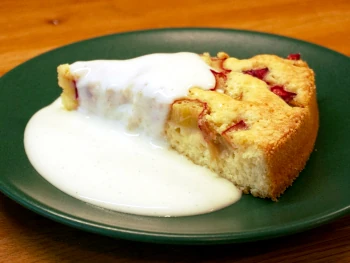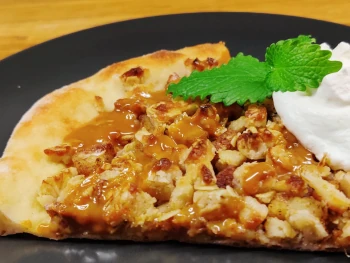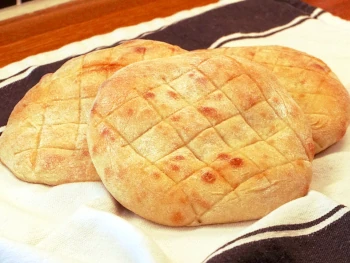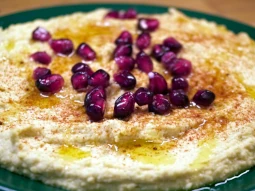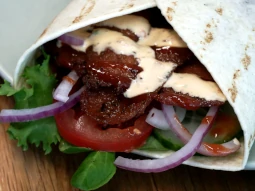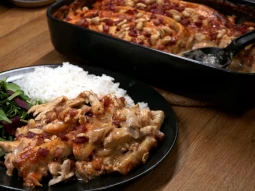One of the most popular pizzas in Sweden.
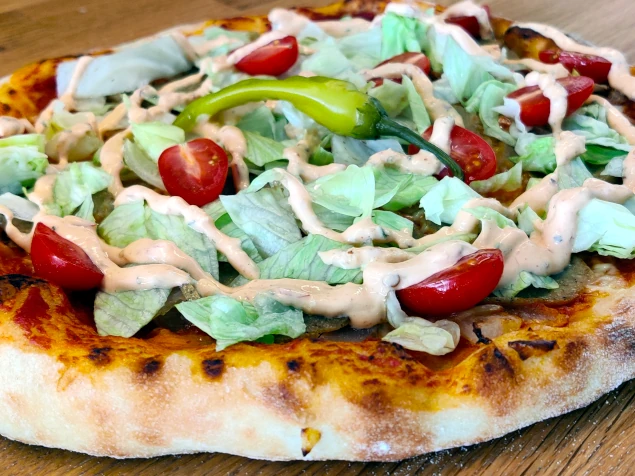
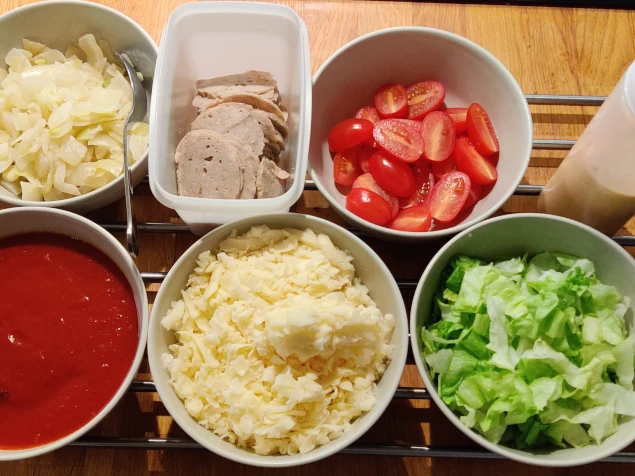
| Servings | 4 Portions |
| Tags | Flour | Italian | Main Course | Pizza | Swedish |
| Allergens | Eggs, Milk, Wheat |
| Prep Time | 30 min |
| Rest Time | 720 min |
| Cook Time | 30 min |
One of the most popular pizzas in Sweden. There are many local varieties, but there is hardly any pizzeria in Sweden that can exist without a kebab pizza on the menu. This type of pizza is usually considered Swedish and has inspiration from both German, Turkish and Italian cuisine. It has been one of the best-selling pizzas in Sweden during the 2000s. The kebab pizza is believed to have originated in connection with many pizzerias starting to serve the German version of Turkish kebabs and the wonderful idea of combining these into something new and fantastic.
Some common toppings on a kebab pizza are tomato sauce, cheese, onions, kebab meat and kebab sauce. Many pizzerias even put one or more fefferonis on the pizza and I have also seen some who put them next to the pizza in the pick-up box (it is not uncommon for them to never be eaten but instead thrown away immediately). In this recipe I have also added fresh iceberg lettuce and tomatoes, which according to some pizzerias makes it a "kababpizza special", but what exactly a "kababpizza special" have for toppings can vary greatly.
From personal experience, this pizza is perfect to order when you are baked. Swedens pizzerias are always in full swing around New Years Eve and especially on New Years Day, I suspect that a lot of kebabpizzas are sold then - I know that I have bought many at that time. By the way, did you know that the first Swedish pizzeria opened in 1947 in Västerås? It was not until the 1960s that pizzerias began to appear around Sweden and then quickly became the most popular fast food. Kebab did not appear in Sweden until 1980, so the concept of kebabpizza is relatively new.
This particular recipe is really what started my latest wave of "how difficult can it really be" in terms of food. Since pizza in general has been quite difficult to perfect at home, it was one of the first things I started digging into a lot of years ago. In recent times, however, lots of accessories for the kitchen have appeared that make it much easier. You can even buy really good smaller ovens that are specifically created to cook pizzas at a high temperature at a reasonable price. But just a good pizza steel helps to turn the oven at home into a good enough alternative to buy the pizza and it is also very satisfying when everything comes together and the pizza comes out steaming with slightly burnt edges and perfectly cooked bottom from your own oven. However, it is not easy to make good pizzas at home so some training may be needed - I have experienced my fair share of failures when it comes to pizzas at home:
- When you handle the dough to hard and tear it apart so it is not possible to repair it again.
- It takes too long after the topping has been put on so that the pizza absorbs the flour that is supposed to be underneath and makes it easy to move from table to oven.
- When the pizza gets stuck on the pizza spade so that instead of slide it over to the pizza steel, you roll over it and create a kind of pizza lump instead.
- I missed the pizza steel with a part of the pizza which then started to hang down and dropped ingredients on the bottom of the oven which then started to burn at once.
- Too short or long time in the oven. Not letting the pizza steel have time to heat up properly can lead to some problems.
- And the most common has probably been that I wanted too many toppings on the pizza, which made it difficult to handle and also cooked unevenly between the toppings and the edge.
So I think I can offer some sensible tips based on both failures and successes in my kitchen when it comes to homemade pizza:
- Use Neapolitan pizza dough. It may sound harder and requires a lot of work and time, but after doing it a few times you realize how much better it gets compared to many other doughs.
- Try using one of the techniques available to shape the balls of dough into the pizza base using your hands. Never use a rolling pin as you will get a flat and dull result.
- You do not need a lot of fancy equipment to make pizza at home - a wide and ovenproof frying pan is enough to get started. If you think its fun and you get good results, you can invest in more equipment later. However, you need an oven that can reach over 250°C and that has a grill.
- Do not use too much toppings on the pizza. It becomes more difficult to handle and can be cooked unevenly.
- The pizza may need to be rotated in the oven depending on how the grill element works. However, this is not particularly difficult, but every time you open the oven a little heat disappears, so make sure to do it quickly.
- Let it take some time between the pizzas so that the oven / pizza steel / frying pan has time to reach the intended heat again.
- All ovens are a little different - experiment and see what works for yours.
Ingredients
Directions
- Prepare the pizza dough according to instructions in that recipe. The dough needs to rest in the fridge over night.
- Cook the tomato sauce according to instrucions in that recipe.
- Cook the kebab meat according to instrucions in that recipe.
- Make the kebab sauce and keep it refridgerated.
- Chop the onion, fry in butter until soft.
- Slice the kebab meat in thin slices.
- Using one ball of pizza dough (1/4, about 210g) and create pizza bottom.
- Add tomato sauce, fried onion, cheese and slices of kebabmeat.
- Cook in oven using a pizza stone/steel or a cast iron pan. Try to get the oven to at least 280°C. The cooking time is different for all ovens, so watch it constantly.
- When cooked, remove and let rest. Add lettuce, tomato and kebab sauce. For an extra swedish touch - add a fefferoni.
Nutrition Facts*
| Total | Serving | 100 g | |
|---|---|---|---|
| Energy | 3480.51 kcal | 870.13 kcal | 159 kcal |
| Carbohydrates | 421.82 g | 105.46 g | 19.27 g |
| Fat | 123.24 g | 30.81 g | 5.63 g |
| Protein | 165.27 g | 41.32 g | 7.55 g |
| Sugar | 54.94 g | 13.74 g | 2.51 g |
| Salt | 24.08 g | 6.02 g | 1.10 g |
* The nutritional information provided is approximated and calculated using the ingredients available in the database. Info will vary based on cooking methods and brands of ingredients used.I am not a certified nutritionist. Please consult a professional nutritionist or doctor for accurate information and any dietary restrictions and concerns you may have.
